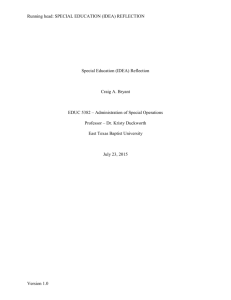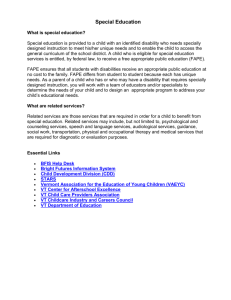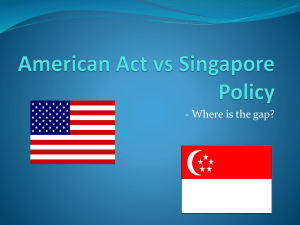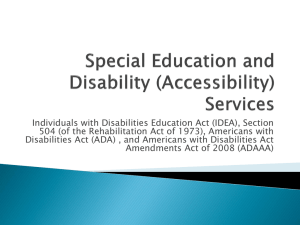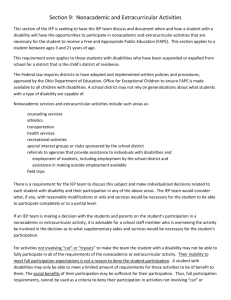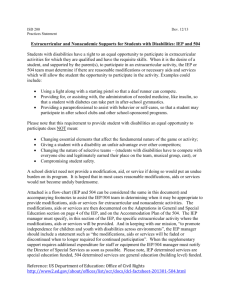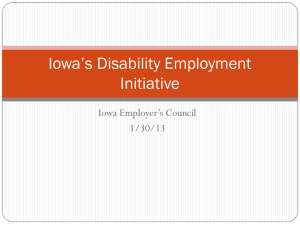Extra-Curricular Activities and Students with - SEP-Jr-High
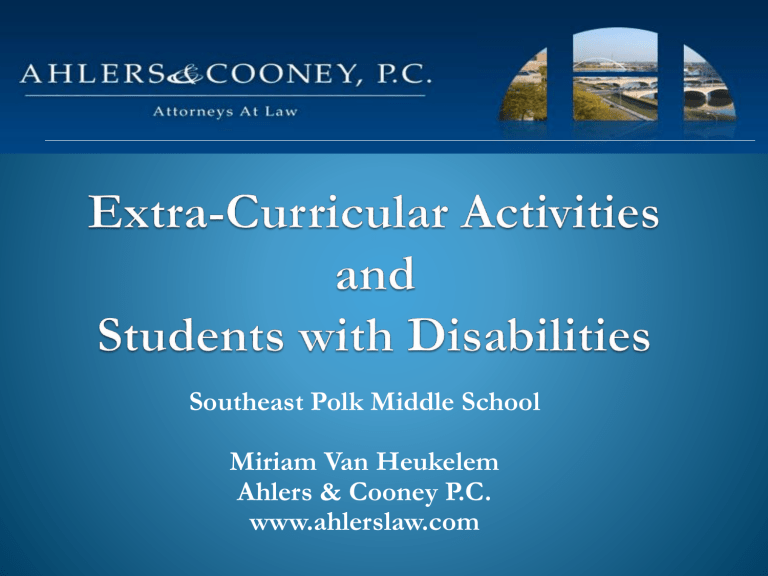
Southeast Polk Middle School
Miriam Van Heukelem
Ahlers & Cooney P.C.
www.ahlerslaw.com
Participation by Students with Disabilities in Nonacademic Activities
This is not a matter of individual discretion!
Federal, state, and local law/policy provide rights and protections to students with disabilities relating to participation in athletics, field trips, and other extracurricular and co-curricular activities.
Failure to follow these laws or policies can expose the
District and employees to legal liability.
Federal Law
The Individuals with Disabilities Education
Act, 20 U.S.C. § 1400 et seq., 34 C.F.R. pt. 300.
Section 504 of the Rehabilitation Act of 1973,
29 U.S.C. § 794, 34 C.F.R. pt. 104.
Iowa Law
Iowa Special Education law, Iowa Code ch.
256B, 281 Iowa Admin. Code ch. 41.
The Iowa Civil Rights Act, Iowa Code § 216.9
(prohibits discrimination against a person with a disability in any school program, including extracurricular activities and athletics).
Southeast Polk CSD Board Policies
Board Policy No. 103: “The board is committed to the policy that no otherwise qualified person will be excluded from educational activities on the basis of…disability.”
Other Board policies that apply to participation in athletics, field trips, and other school activities (e.g.
Good Conduct rule).
Three Main Principles
Equal Opportunity
Non-discrimination
Least Restrictive Environment
Equal Opportunity/Access
The IDEA requires that school districts take steps – including providing supplementary aids and services in a child’s IEP – to provide students with disabilities with an equal opportunity for participation.
Section 504 prohibits exclusion from an activity solely on the basis of a student’s disability, if the student is otherwise qualified to participate in the activity.
Are there limits to Equal Access?
If uniform competitive standards for an activity have been established, those standards generally do not need to be waived.
A student with a disability does not need to be given a
“competitive advantage” over nondisabled students.
Districts do not need to “fundamentally alter” the nature of an existing program.
Activities need to be created where they do not already exist.
Nondiscrimination
A school district may not:
Provide a qualified student with a disability the opportunity to participate in an activity that is not equal to, or not as effective as, that provided to nondisabled students.
Provide separate or different activities or services to students with disabilities without (legally) justifying the different treatment.
Otherwise limit a qualified student with a disability in the enjoyment of any right, privilege, advantage or opportunity enjoyed by other nondisabled students.
34 C.F.R. § 104.4(b)(1).
Least Restrictive Environment
Both the IDEA and Section 504 require that qualified students with disabilities participate with nondisabled children to the maximum extent appropriate to the needs of the child – LRE.
Socialization opportunities for students with disabilities participating in these activities are often considered to be among the most valuable aspects of inclusion.
When Can Access be Denied?
If a student cannot perform successfully with nondisabled peers even with the use of supplementary aids and services/ reasonable accommodations.
If the student’s presence in the setting has a negative impact on other students – exclusion may be justified if the student’s participation significantly interferes with the activity or poses a significant threat to the student or others.
A student may be suspended from participation as a disciplinary measure, but only if all students would be subject to a similar sanction for similar behavior.
Medical Issues
Some students may have medical issues affecting their ability to participate in an activity or field trip:
Decision of whether to allow participation must be made on a case-by-case basis.
If the facts warrant, may ask for medical clearance.
Generally, exclude only if you have medical information that a serious health or safety threat exists to student or others.
Factors to consider
When considering whether a student’s disability might create a serious health or safety threat to the student or others, some factors to consider include:
The student’s history of participation in similar activities;
Severity and likeliness of potential harm;
Whether harm to student is more likely than harm to others in similar situation;
Whether there are requirements or guidelines for participation that apply.
The IDEA and FAPE
“Nonacademic services and extracurricular activities” under the
IDEA include “athletics, recreational activities, special interest groups or clubs sponsored by the public agency.” 34 C.F.R. §
300.107(b). The Section 504 definition is almost identical.
Participation in these services is not usually considered to be part of the legal requirement to provide an eligible student with a Free
Appropriate Public Education (FAPE) under the IDEA. These activities are provided by schools for enrichment – to maximize students’ learning opportunities.
The IDEA and FAPE
However, if the IEP team determines that participation is a necessary component of providing the child with a FAPE, the child is legally entitled to participate.
This is a high stakes issue – a majority of courts have ruled that under these circumstances, a school cannot place any restrictions on the student’s participation.
This means that even a generally-applicable, nondiscriminatory standard cannot be used to bar a child from participation!
Suggestions for Implementation
The IDEA assigns responsibility to the child’s IEP team to determine appropriate supplemental aids and services:
Be proactive – ask the student or parent about activities the child might be interested in joining.
Invite the coach/sponsor to an IEP team meeting to discuss:
The nature of the activity,
Any uniform standards for participating in the activity, and
Whether services, supports, reasonable accommodations could be provided to enable the student to participate.
Suggestions for Implementation
If a student will participate in an extracurricular activity, the
IEP team needs to be clear about whether participation is necessary for the student to receive a FAPE.
If so, this should be clear in the IEP – why, how, what goal(s) does participation impact.
If not, it should be made clear in the IEP or 504 plan (and a prior written notice) that the student is being provided with an equal opportunity to participate, along with a statement of the supports/accommodations that will be provided.
Suggestions for Implementation
Competitive activities should have well-defined and clearlycommunicated eligibility criteria that are uniformly applied:
Attendance or behavior requirements,
Coursework requirements or standards,
Application procedures, and/or
Standards for making the team.
District policies should be uniformly enforced, as applicable:
Good Conduct code,
Disciplinary rules, and/or
Field trip policies.

